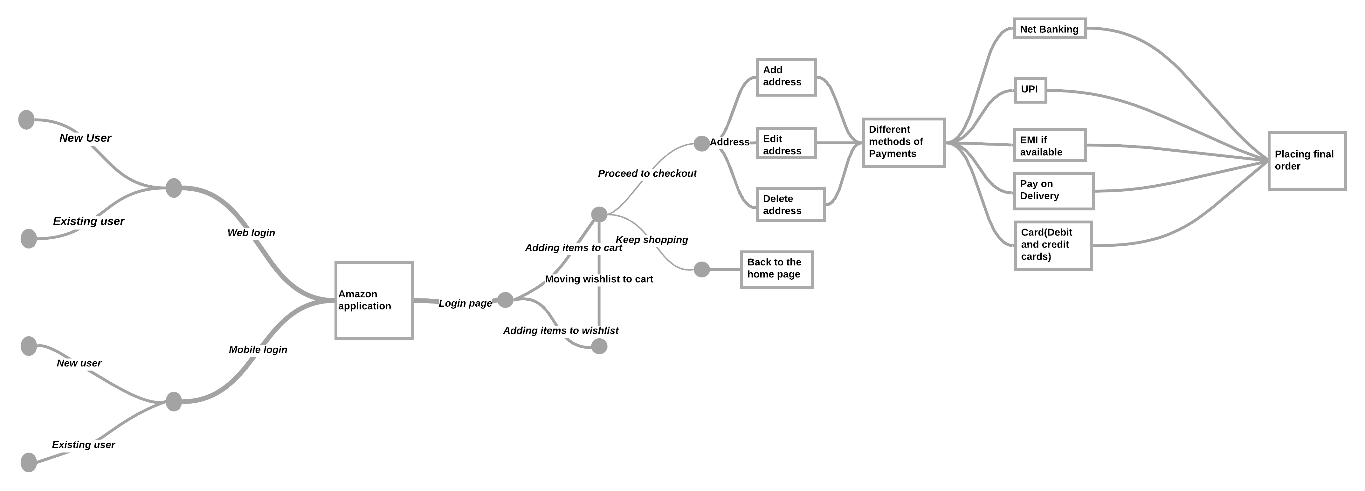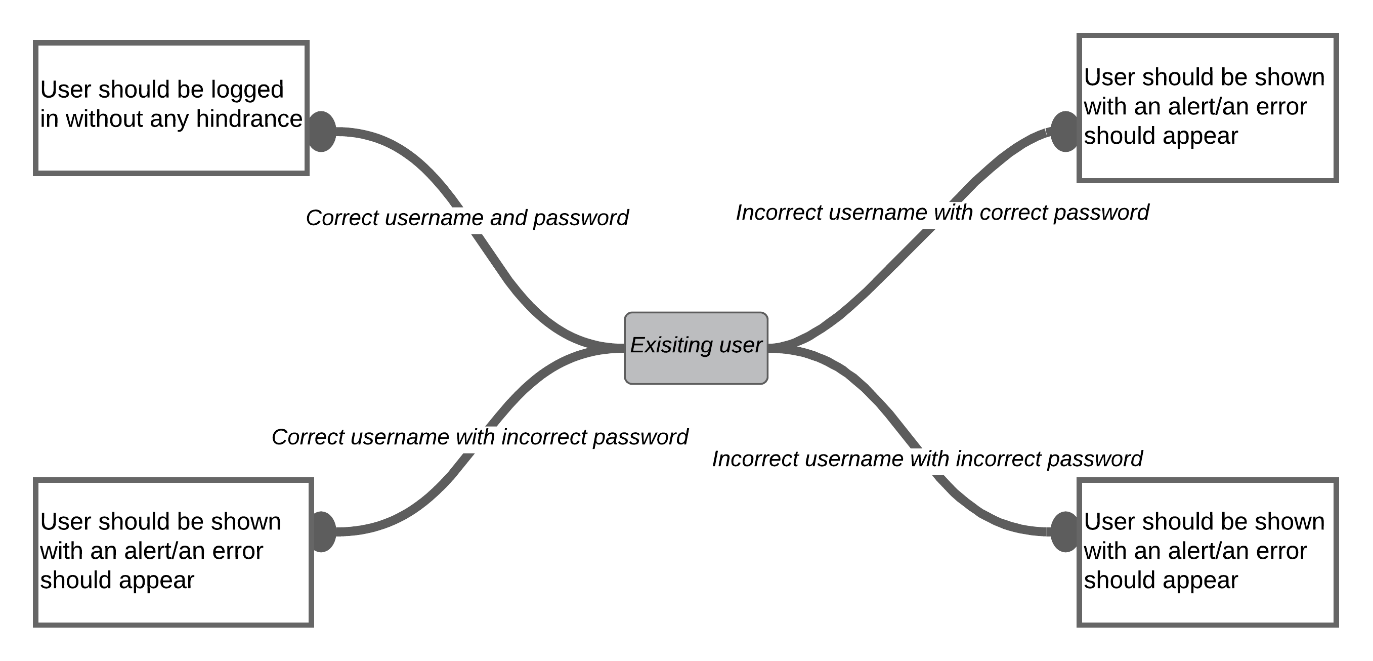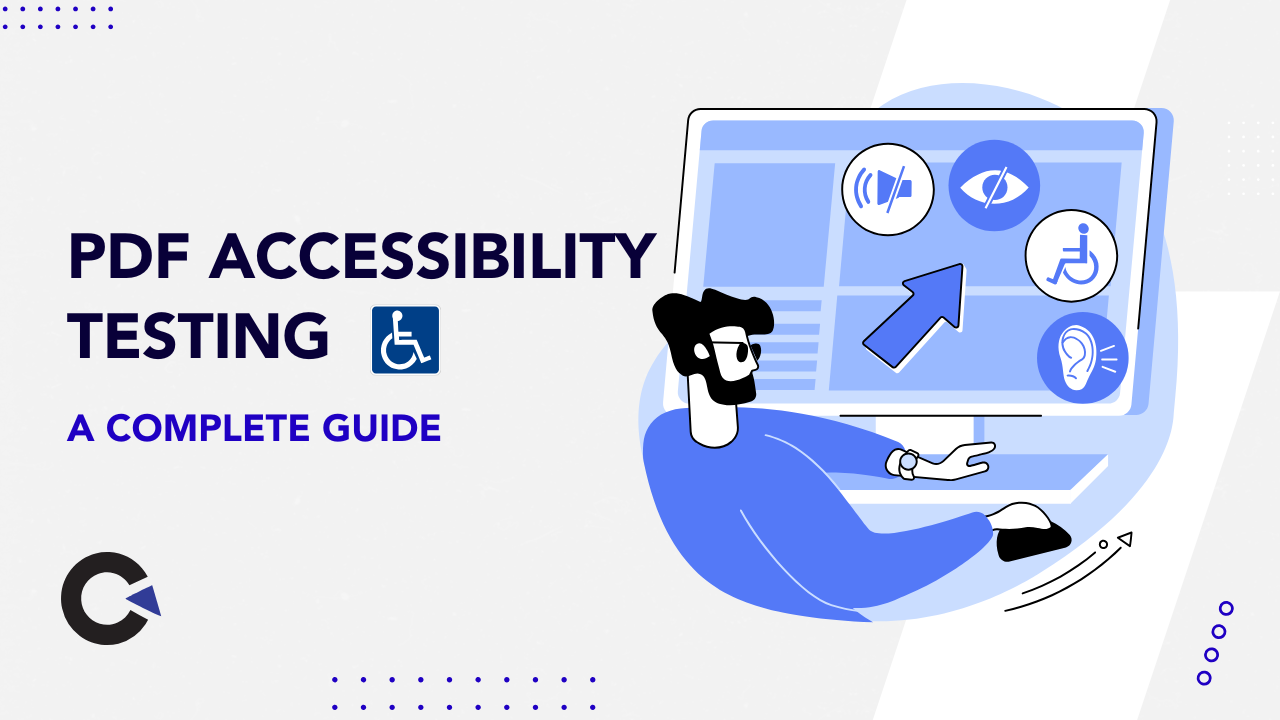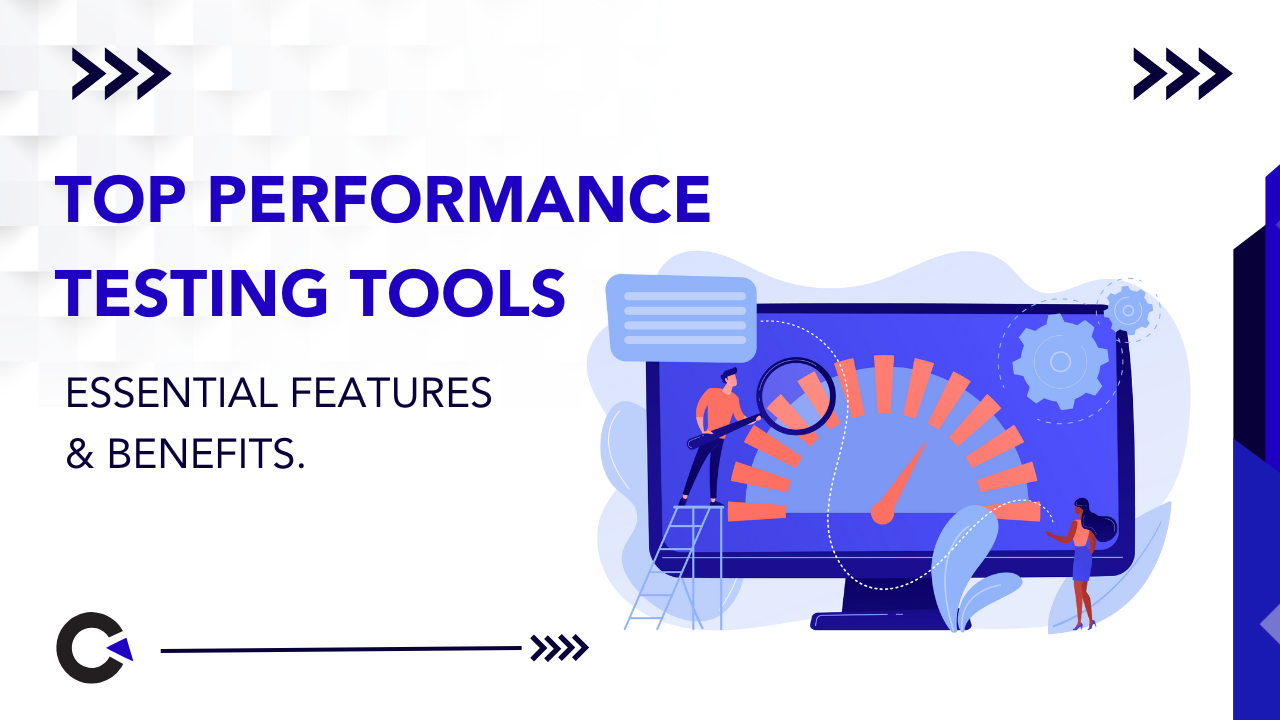
by admin | Jan 31, 2022 | Exploratory Testing, Blog, Latest Post |
There are many well-known definitions for exploratory testing (ET). Out of those, the most common one was coined by James Bach and Cem Kaner. That is, “Exploratory testing is simultaneous learning, test design, and test execution”. This definition has changed over the years to become “Exploratory testing is an approach to testing that emphasizes the freedom and responsibility of each tester to continually optimize the value of their work. As a leading QA company, we achieve this by treating learning, test design, and test execution as mutually supportive activities that run in parallel throughout the project”. Since exploratory testing can be defined in many different ways from different perspectives, it is very common for many to create a few misconceptions. So in this blog, we will be myth-busting the most common Exploratory Testing misconceptions.
Exploratory Testing is not Adhoc Testing
We are starting off with this point as viewing exploratory testing as ad hoc testing is pretty much the most famous exploratory testing misconception. If you look at both these approaches on a surface level, they might seem the same. For example, both these approaches do benefit from having an experienced tester perform the tests. But if you dig deeper, you will be able to see the differences. For starters, Adhoc testing doesn’t have any structure or proper documentation. But exploratory testing does in fact have both structure and documentation and that is our next point of discussion.
Exploratory Testing needs Planning
The most common Exploratory Testing misconception is that it can be done in any random way we desire without any plan. But in reality, exploratory testers use test charters that will prevent them from going overboard by maintaining a certain boundary. If test charters provide the boundary for the scope of the tests, then time boxing creates defined timeframes for exploration.
But the point to keep in mind is that these test charters shouldn’t be too detailed. Test charters should only help you focus up and shouldn’t become like detailed test cases. In addition to that, it will also be helpful when it comes to traceability.
Exploratory Testing requires Documentation
Now we know that creating test charters will not take as much time as creating test cases as it doesn’t need to be too detailed. So mind mapping the ideas or focus points that need to be documented can help us stick to the context and make sure we are not testing beyond the documented ideas. Likewise, mind maps can also be very helpful in identifying the steps to reproduce a particular bug as we can trace the steps taken during testing. We have covered the importance of using mind maps for exploratory testing documentation in detail. Make sure to read it for additional information. Performing exploratory testing and not having even test notes will make it very difficult to keep track of the bugs that were found, and most importantly fix them as well.
Exploratory Testing requires Training
The other common exploratory testing misconception is that people believe that it doesn’t require any sort of training and can start immediately. But just as seen in the previous points, there are various techniques like mind mapping that will come in handy during exploratory testing. So make sure to train yourself with the 5 exploratory testing techniques that we have mentioned in this blog to witness the improvements.
One of the 5 exploratory techniques is Integration testing as you should be in a position to test every module that comes your way in the way you want it to be tested. You will also start seeing better results in your exploratory testing as you gain valuable experience. So make sure to keep a learning mind when you perform the tests.
Exploratory Testing is not test-case-based testing
Though you may not have had this exploratory testing misconception, the recent points might lead you to wonder if exploratory testing is almost like test-case-based testing. But in fact, exploratory testing brings the best values from ad hoc testing and test-case-based testing to achieve more robust results. For example, though we have the test charters and time boxing elements to guide us along, the limitation of staying within the test cases alone is eliminated in exploratory testing.
The tester will have the freedom to use their experience and follow their hunches to detect bugs that would usually go untraced. Plus exploratory testing can be performed even at the very initial stages of development to find and fix the bugs at the earliest. You could visit our comparison blog of Scripted Testing vs Exploratory Testing to get an even clear idea about the distinction.
We can employ both test-case-based testing and exploratory testing
We have established the fact that exploratory testing is different from the regular scripted testing in our previous point. So using both the scripted and exploratory approach when testing the same product can be an effective way to find more bugs. Having predefined scripts based on what we know alone will never be enough. So using the knowledge we gain during exploratory testing is the best course of action.
As stated earlier, you can use exploratory testing during the initial phases of development and cut off the bugs at an earlier stage. By that time, the application will be ready for us to perform scripted testing to root out the remaining bugs. Likewise, we can also use scripted tests to attain maximum coverage and use chartered exploratory tests wherever needed to bring about the best results. Speaking of test coverage, let’s move to the next exploratory testing misconception.
Exploratory Testing isn’t about Coverage
Exploratory testing is a very subjective approach that depends on the individual tester who is in control. We would have heard many say that exploratory testing expands the test coverage. The implication here is that exploratory testing will be instrumental in finding the bugs that would usually go untraced in the conventional approach. The tester will have the option to test different scenarios and target the weak spots that have been identified instead of testing everything. So though it is possible to attain maximum coverage, it wouldn’t be necessary if you couple exploratory with scripted testing.
Exploratory Testing isn’t Troubled by Complexity
By this point, you yourself know that exploratory testing can be done irrespective of the complexity of the product. Since exploratory testing is a reactive process that is influenced by what we learn during the testing process, the complexity of the product will never be a factor. Irrespective of the approach you use, you must have ample experience and skills with the different testing techniques to keep up with the complexity. In fact, you will even get better ideas for testing a complex product because of the context you can observe and understand from the hands-on experience.
Conclusion
As a leading Exploratory testing services provider, our first step towards providing better results was clearing the common misconceptions behind the approach. Just a sweet reminder that there is no conclusive evidence or definition for exploratory testing is as of now. So don’t end up with the single known definition or any not-proven conclusion of exploratory testing. Instead, charter your learning experience in exploratory testing by understanding the common Exploratory Testing misconceptions. We believe it greatly helped us out understand what exploratory testing truly is and hope this blog will be very useful for you as well.

by admin | Jan 4, 2022 | Exploratory Testing, Blog, Latest Post |
Performing effective Exploratory Testing is not everybody’s cup of tea. But that doesn’t mean you have to shy away from it thinking it’s not for you or thinking you’ll be able to do it only after gaining a lot of experience. As one of the top QA companies, we have curated this exploratory testing checklist from the vast experience we have gained over the years. We have always found exploratory testing to come in handy in various projects as it helps unearth the software bugs that flew under the radar of the various test cases. So without any further ado, let’s take a look at the exploratory testing checklist and then explore them one-by-one in detail.
The Exploratory Testing Checklist
- Charter Your Exploration
- Don’t make your Charter a Test Case
- Think from the user’s perspective
- Interview the Stakeholders
- Using time-boxed Sessions
- Learning while Executing
- Use Variations
- Create proper documentation
- Mind Maps
- Defect list and Debriefing notes
- Console and Logs
Charter Your Exploration
Exploratory Testing can be compared to exploration missions to easily get an idea of how to execute it. You can either wander around without any particular target with the hope of finding something or you can start your mission with a target in mind. You then have to plan a course as per the resources you have at your disposal to be more effective in your exploration mission and find the target.
Likewise, you can start out by defining what to explore (a particular module, or the entire app). Following which you can utilize the resources such as testing tools, data sets, exploratory testing techniques, and so on. You should be clear of what your target is as an exploration session without any target is not a good idea. So be sure of whether your objective is to test the app’s security, performance or test it on the whole.
A Charter isn’t a Test Case
The more and more details you add to a charter, the more and more it becomes like a test case. And that is something you should avoid at any cost. If your charter becomes like a test case, the point of performing exploratory testing is compromised. But at the same time, you shouldn’t let it be too vague as it’ll not be an efficient way of doing exploratory testing.
Since charters will not have all the expectations mentioned in an explicit manner like a test case, you have to analyze and pick up implicit expectations. For example, it goes without saying that a mobile banking app has to have a secure login feature that works only if the correct pin or password is entered. If that condition isn’t fulfilled, then it has to be explored even though it isn’t mentioned in the charter. You can call it the ‘Never and Always’ approach as all the app should always be able to achieve a few functionalities like providing a safe login and should never do certain activities like sign the user out every time the app is closed.
Put yourself in the User’s Shoes
Since it can be tricky to strike the balance between the two extremes to perform effective exploratory testing, the best strategy to not go astray would be to test by putting yourself in the user’s perspective. User workflows are so diverse in nature that they can’t be covered in just test cases. With this approach, you will easily be able to go beyond just testing functionality and test the app’s usability with the help of effective user stories.
Interview the Stakeholders
As we said earlier, exploratory testing makes it possible to detect potential future risks. Thinking from the user’s perspective will solve only half the problem. The other half can be solved only when you have a chat with the stakeholders. Once you do that, you will be able to understand the vision for the app in the longer run, discuss the priorities, understand the concerns of the stakeholders, and so on.
Time-Boxing
Time-Boxing should be an integral part of any exploratory testing checklist as even your well-developed charters can let you go down the wrong road and waste your time without it. When it comes to scripted testing, we will not be able to explore areas of concern immediately. But here once we have a hunch or a gut feeling about a probable issue, we will have the freedom to explore it and detect the bugs.
But you have to understand that not every assumption you make might lead to the detection of bugs. So make sure to time box your sessions so that you don’t get carried away with the exploration process. As one of the best manual testing companies, we have found timeboxing highly beneficial to our testing process. So if you are in a position to analyze your exploration and test accordingly, it will definitely yield good results. You have to be quick to learn and adapt your tests accordingly.
Learning while Executing
Learning while Executing has made it to this exploratory testing checklist as it is probably one of the biggest challenges you might face. A good exploratory tester will be proactive when performing the tests. Testing is accustomed to seeing the results we’d hope to see on most scenarios as you’ll have a well-defined test case. But in the case of exploratory testing, you’ll have to look beyond what you’d expect to see to find out what is actually happening and unearth hidden bugs that would usually go undetected.
The more you understand the app, the better it will be for you to guide yourself throughout the exploratory testing process. You will be able to not just detect bugs, you will be able to detect the root cause of such issues and find a cluster of bugs that are interlinked. You’d have to have an open mind while performing exploratory testing as rigid beliefs and generalized assumptions are traits that you should steer clear from.
Use Variations
Variations are an integral part of exploratory testing. It has made its way to our Exploratory Testing Checklist as you’d have to implement such variations based on what you learn on the go to be effective with your exploratory testing. But there are a few constant variations that you should look to cover. Let’s take a look at a few.
- CRUD – Create, Read, Update, and Delete are important actions you have to test with whenever there is data involved.
- Starve the application of any required information to see how it handles the situation. You can also give partial information or excessive information to see what happens as well.
- Play around with the data formats and speed of input to ensure things don’t go wrong.
- Centralizing and decentralizing the data or configurations of the application might also reveal undetected bugs.
- Create intentional interruptions to explore the various stability issues that might arise.
We could just keep adding to this list, but we hope you get the idea. The fact to remember when it comes to using variations is that there are an infinite number of possible variations and it is not possible to test everything. So make sure to explore the interesting ones alone based on your targeted user base.
Documentation
The purpose of any type of testing isn’t just to identify bugs. Rather, the goal is always to identify the bugs so that they can be fixed. This cannot be achieved without proper documentation as if you don’t document your testing, you will never how to reproduce the bug or even find out the cause behind it. So make sure to take notes and keep track of the steps you take as it will also be useful in reviewing and analyzing your exploration on a regular basis. Apart from that, you can use mind maps and use documentations like consoles and logs to be more effective.
Mind Maps
Mind maps are very effective in helping us connect the dots that we might otherwise fail to see. In addition to making it easy for others to recreate the bug or issue to fix it, mind maps will help you detect functionality gaps. Since mind maps can be easily edited by adding or removing nodes, they will also suit the testing style employed in exploratory testing. Mind maps are a great match for exploratory testing as one will be able to be guided properly without needing too much information.
Defects list and Debriefing notes
Knowing how much is enough is an important aspect of exploratory testing. So with the notes you have taken for your reference during your exploration, you have to create a defect list to make sure no defect gets overlooked. You must also create debriefing notes wherever necessary to help the team understand your approach, and take input from your actions.
Inclusion of Identified Test Case
If we were to compare exploration testing to exploration again, then it’s obvious that we should keep a track of the routes that we have already taken. Likewise, once you have found an issue when testing your app, make sure to add relevant test cases of it so that further testing can be done and avoid exploring the same route again. But it doesn’t mean you have to stop exploring the entire area. You just have to avoid the same route. Here the area is a comparison to the entire module or feature and the route is the action you performed to find the bug.
Consoles and Logs
Consoles and Logs are the other warning systems that can help you analyze the inner workings of a system and bring unnoticed errors to your notice. They are a great way to understand the structure of the app which in return will help you attain the required insight to detect internal issues that might go undetected. You have to ensure that your logs don’t get too lengthy by filtering them out smartly. Let’s take a look at an example to get a clearer picture. If you are testing a web application, you should keep track of the JavaScript console, the webserver log, and the application log to detect any anomalies.
Conclusion
So it is evident that an app can be termed as completely tested only if both regular testing and exploratory testing have been completed. If that is done, you can be sure that your application has met the defined expectations and is free from any unexpected liabilities and risks. So we hope this exploratory testing checklist of ours will be helpful for you to get started and eventually become proficient at exploratory testing.

by admin | Nov 16, 2021 | Exploratory Testing, Blog, Latest Post |
There are many subjective factors to consider when choosing between scripted testing and exploratory testing approaches and there is simply no universal right option. An easy way to understand this concept is to compare exploratory testing with improv in art. In certain scenarios, the artist’s talent could complement the improv method and enhance the art. But if used incorrectly in the wrong scenarios, it could degrade the art as well. So if software testing is the art, then the tester’s (artist’s) abilities and the scenario in which the exploratory testing approach is used also play a vital role. So in this blog, we will be pitting Scripted Testing vs Exploratory Testing to understand them better and use them in a way that suits your needs.
Clearing Misconceptions
As a first step, we will clear any misconceptions if there are any as few might confuse exploratory testing with ad hoc testing. We all know that scripted testing is more like clockwork where we define the test cases with every single detail that is needed for a tester to test the software without any deviations from the expectation that has been set. Yes, thinking ahead is a great way to increase efficiency, but it is not always the best method to be thorough as it is almost impossible to think of all the possible scenarios beforehand. But on the other hand, we have ad hoc testing that lacks any form of structure or goal. So exploratory testing takes the best of both concepts as it does provide the flexibility that ad hoc has to offer despite remaining structured and goal-oriented.
Scripted Testing vs Exploratory Testing
Staying on track is one area that we should pay a lot of attention to while performing exploratory testing. So let’s take a look at a few concepts that can help you not just stay focused on your goals, but also increase the efficiency of your exploratory testing. In addition to that, we will also be using these concepts to highlight how exploratory testing differs from scripted testing.
Test Charters
Test charters help you define the goals for your exploratory testing sessions. But it is different from your goals in scripted testing as the goals can be changed as you move forward with your testing. Be it scripted or exploratory testing, we always start by analyzing the information we have at our disposal. So when you find something you didn’t expect when you begin your tests, you can redefine your goals based on the new findings and stay focused on them. But when it comes to scripted testing, finding something unexpected itself is not very likely as the approach increases the tendency to see only what you want to see. You begin your software testing with the mindset of finding the bugs you already anticipate. So assigning such fluidic test charters helps you overcome this issue and prevents you from going off the rails.
Test charters should only act like a guide that doesn’t restrict the tester too much. Flying blind is never an option, but restricting yourself too much defies the purpose of exploratory testing itself. So make sure to strike the right balance between both. For example, if you are going to test a certain feature of functionality after changes have been made, then you can define boundaries based on that and test it without having to spend too much lead time that will be needed for performing scripted testing. So you can go about performing your exploratory tests by targeting the different possible scenarios, or by using your experience and expertise to develop a strategy by performing boundary value analysis & risk analysis and by following the equivalence technique. In this Scripted Testing vs Exploratory Testing blog, we will be seeing tips for better implementation under each section as well.
Tip
Classifying the bugs you find while testing or the bugs you anticipate is a great way to help create an outline for your test charter. Use your experience in testing similar software or similar concepts to curate a list of commonly found bugs and work around it. Since there is also a possibility of missing the simplest aspects when using such a method, make sure to create a checklist for the basics to avoid any oversight.
Time Boxing
We have already seen how exploratory testing helps you reduce the lead times before you start the testing process. The time gained here shouldn’t be lost elsewhere by being stagnant on a certain feature, scenario, or module. You must have an in-depth understanding of the software you are testing to create effective test charters. Likewise, that knowledge will also help you figure out how much time you’ll be needing for your tests and create test sessions. Once you start the tests, you will be able to assess the probability of finding bugs in that particular feature or module. Just because you are exploring the software doesn’t mean that you have all day. So if you are not finding any bugs, don’t spend too much time trying to find them. If you have unearthed a deep and unexpected issue that calls for more attention, modify your test session accordingly.
Such adaptability will not be available in scripted testing as you would have to go through with all the steps and tests even if there are no bugs. Yes, it will be very important to follow the scripted testing approach when you are testing critical modules or apps. But if you are in a position to test a module or software at its early stages of development, you can certainly not be able to do everything over and over again as there will be rapid changes in the code. Apart from that, as one of the most experienced Software Testing companies in USA that employ the agile methodology, we can assure you that exploratory testing is a key pillar of the agile development process.
Tip
In addition to saving time, the experience and understanding gained from exploratory testing will be instrumental in developing effective test scripts. So it is evident that you can get the best results when you combine both of these approaches in your project. Apart from time, be aware of the various metrics to gauge your performance during the process.
Divide and Conquer
Testing the application in its entirety is not a good option even if it is a basic application with a fewer number of modules. You’ll lose track of your goals and objectives when testing in such a random manner. So, add structure to your exploratory testing by dividing the software into various modules. So in terms of the approach, exploratory testing is not very much different from what happens with scripted testing in this case. Once you check each module off your list, you will have more insight into the bugs you may find in the application. Ensure you evaluate your original plan based on the results you have in your hand. If you identify any common issue across all the modules, change your plan accordingly. You would also have to look for the root cause of the bugs in each module and improve your test charters with better predictions.
Tip
You can use mind maps to easily identify the root cause and common issues across the various modules. Mind maps will provide you with a visual representation that will help you connect the unseen dots. In addition to that, exploratory testing does require proper documentation for it to be effective and mind maps will come in handy to easily record the issues and evaluate them later on. So for a better understanding of how effective mind maps can be for documentation during exploratory testing, visit our blog.
Exploratory Testing Techniques to Master
Though the individual skills of the software testers who perform both these types of software testing are important, the skills do play a more vital role when it comes to exploratory testing. So if you are focused on improving your exploratory testing skills, then make sure to read our blog about ‘The 5 Exploratory Testing Techniques to Master’. If not, here is the list of the 5 techniques we have explored in that blog.
- Exploring User Stories
- Being Bold Enough to Test New Waters
- Getting handy with Mind Maps
- Improving Your Integration Testing Skills
- Following an End-to-End Approach
By now you would have clearly understood that the experience of the QA performing the exploratory testing is very important. Experience alone isn’t enough as only dedicated work in those years of experience will equip you with the required expertise to do effective exploratory testing. Experience is something that you can’t get overnight, but the above-mentioned techniques will definitely help your cause.
Conclusion
So to sum things up in this Scripted Testing vs Exploratory Testing blog, exploratory testing is a great option when you want to test during the early stages of software development. Since exploratory testing is a context-driven approach, it will also be a great choice to use when following the agile method of software development as it helps keep up with the short scrum cycles. It is also a great way to identify usability issues in comparison to scripted testing methods. But exploratory testing alone is not enough by any means. As one of the best Automation Testing Companies, we also focus on scripted testing as automation is easier to implement in this approach. You can also avoid any oversight issues or bias issues by following the scripted testing approach. So we would highly recommend you to use both these methods for the best results.

by admin | Oct 25, 2021 | Exploratory Testing, Blog, Latest Post |
Exploratory testing is one of the types of testing that will highly benefit from the QA’s or tester’s experience, expertise, instinct, and intuition. Unlike many other types of testing, there will be no scripted and defined steps one would have to follow. The implication here is that the person performing the tests will either make or break the results as they will be flying blind without any guidelines to adhere to. So if you are a QA professional looking to make a mark, then we recommend you to master these exploratory testing techniques we have listed in this blog. It will help you become better equipped to perform effective exploratory testing. We will start out with the basic techniques and then explore the more high-level techniques as well.
To be clear, exploratory testing may not need a prescribed method, but it definitely will require a goal or objective based on which we can use our own skills to get the job done. We will not be creating a fully defined script, but we should create charters. Charters are guiding statements that will help us avoid any kind of confusion. For example, the charters will be used to define aspects like what function has to be tested, who it has to be tested by, and what type of approach has to be used. If you are fairly new to exploratory testing, you could read our quick guide about it.
User Stories
User stories also known as user scenarios can be termed as a description of a user’s workflow when using one of the application’s functions. To put it in simple words, it’s putting yourself in the shoes of the end-user to think of the possible steps the user would have to go through to use the intended feature. The more and more you familiarize yourself with creating such user stories, the better your critical thinking will become and help you in assessing the diverse workflows of various users.
You also have to make sure not to mix app functionalities with the user’s needs. For example, if you are testing an app that can be used to sell used products, you should test it from the perspective of a person listing the product and from the perspective of a person trying to buy that product. Make sure you don’t mix both perspectives just because the app’s features allow you to. Stay focused on each user’s story and not deviate away.
Test New Waters
Testing with the same type of approach you would use doing regression testing will not help you perform good exploratory testing. You would have already tested if the expected results are achieved in a logical way. So make sure you explore new unorthodox ways of doing the same process. By doing so, you will go beyond just confirming the functions. For example, let’s assume yourself to be a user who is trying to book a flight ticket in a hurry. In the heat of the moment, such a user could make a lot of mistakes a regular user may not. So those possibilities could be explored to unearth new bugs.
But it is also crucial to not indulge in highly unlikely scenarios and waste your time. This is where your experience and expertise will come into play. You should be able to assess where possible flaws could be when testing the application. But how can you do that? Let’s find out in our next Exploratory Testing Technique
Mind Maps
Visually represented data will always help you analyze your options better to take better decisions, or even understand the process more easily. So when you use mind maps during exploratory testing, you will be able to identify functionality gaps. Though you will not be able to reap the full benefits overnight, you will be on the right path towards growth. Once you become well worse at using mind maps to find functionality gaps, you would have the potential of identifying issues even before they become bugs. As a leading manual QA testing services provider, we always try to incorporate mind maps and visual aids wherever possible to make our testing more organized and effective.
Improve Your Integration Testing Skills
One skill that will come in very handy when you expand your coverage with exploratory testing is your integration testing skill. Let’s say you are testing an application that maintains inventory and you have used your mind map to find out that there might be an error with the price adjustment in existing stock. So you would have to see if that impacts your billing or just the valuation of the stock. Since you would have to test both the inventory functionality and billing functionality, it can be understood that integration testing is very important.
An End-to-End Approach
You should go beyond just the front-end and bring the back-end processes into the picture as well. There might be third-party integrations that are key to certain functionalities. In that case, check how and where the application saves the data to its database and calls it whenever necessary. APIs are widely used for data feed purposes and since data feeds happen at fixed intervals, target those times and check them for failures. Though this approach requires a lot of knowledge, it is something that you can’t simply afford to miss. So you should enhance your understanding of how an application works by making analyzing it from its core.
Conclusion
Exploratory testing without any doubt does require time for one to master. As one of the best manual testing companies, we believe that these exploratory testing techniques can boost the rate of growth. You shouldn’t just be focused on obtaining experience, you should be focused on learning as much as possible during that time to get a deeper understanding of the entire process. So you have to be on top of your game to prevail as an exploratory tester over time.

by admin | Sep 7, 2021 | Exploratory Testing, Blog, Latest Post |
Exploratory testing is so widely used nowadays that almost all agile methodology projects use them to good effect. So if you’re wondering what makes exploratory testing an important component that is needed for a product to be successful, we have a simple answer. Exploratory testing has the potential to not just identify, but to even resolve certain issues that may have gone unnoticed during scripted testing. But what makes it that way? If you give it some thought, you will understand that scripted testing doesn’t capitalize on the tester’s expertise. Though it has its own advantages, scripted testing alone is no longer enough to meet high-quality standards. As a leading QA company, we have employed mind maps for our exploratory testing documentation in various projects. So in this blog, we will be exploring why you should document exploratory testing using mind maps.
Exploratory Testing
Let’s have a brief introduction to exploratory testing before we head over to the exploratory testing documentation part. To put it in simple words, exploratory testing is a software testing method that involves focusing on the requirements, the test design, and the test execution at the same time. It’s a hands-on technique in which testers are involved in as little planning as possible while still performing as many tests as possible. Usually, in testing, the test cases are written in advance along with the expected results. After which, the testers will perform the tests and compare the actual result to the expected result.
What makes exploratory testing different is that the expected results are not defined, as not all results can be predicted. As mentioned earlier, exploratory testing can be used to tap into the potential of a seasoned software tester who has vast experience. Moreover, only an experienced tester will be able to perform effective exploratory testing as a fresher who might be even able to perform automation testing will suffer without experience. But it is a well-known fact that experience alone doesn’t make a person more adept in their field. So it is vital that the tester has the required expertise as well.

Why is Documentation Necessary?
Quality can’t be achieved by just finding the bugs, it can be achieved only if the identified bugs are fixed. That is why good documentation is an integral part of exploratory testing. Just imagine yourself being on any team, be it sports, IT, or any domain, it is of paramount importance that all the players on your team are on the same page as you. If there is a lack of communication within the team then you would no longer function as a team, rather you would be functioning as an individual in a group. Good documentation doesn’t just make it easy for every person on your team to understand your actions, it’s also instrumental in helping you maintain a record of your actions that can be used to reflect upon and create new strategies.
There are multiple ways one can document the test cases, but just like how exploratory testing has its distinct advantages, let’s find out what are the plus points of using mind maps for exploratory testing documentation.
Exploratory Testing Documentation using Mind Maps
Mind maps in general, have a lot of advantages for many use cases. But in this blog, we will be focusing on what makes them apt for documenting exploratory testing. Unlike formal descriptions, the structure of mind maps is very much adaptable to changes. It is a powerful approach that has the capacity to improve learning about the application/product and enable testers to solve the problem in creative and efficient ways. Since the expected results are not defined in exploratory testing, we can add new nodes during or after execution to cover the entire application. You can create as many test cases as you want in your mind map using different nodes, you even can add a node, edit an existing node, or delete a node as per the requirement.
For a better understanding of the exploratory testing documentation, let’s take a look at an example. The mind map we have used below illustrates the exploratory testing flow for the process of ordering a product from Amazon.
Mind Map for Ordering on Amazon

If not for exploratory testing, a tester would generally
→Check for the navigation smoothness
→Cosmetics check on each page
→Check for the timeout session
→Check for the amount deduction, reduction, etc.
But as an exploratory tester, he/she would have to perform the test cases using both mobile and web login. So mind maps are a great option for the high number of combinations that would be required during exploratory testing.
If the tester had to perform the same action, but as an existing user, then the general way to write test cases would be,
Positive test cases:
The primary objective here is to ensure that the login is successful when the correct credentials are given.
Entering correct email id or the phone number → Okay
Entering correct password → Okay
Negative test cases:
The objective here would be to ensure that the login is successful only when the correct credentials are given. So we would have to try out different combinations to make sure that everything works correctly as planned.
Combination 1 :
Entering incorrect email id or phone number → Okay
Entering the correct password → Supposed to throw an error → Okay
Combination 2 :
Entering correct email id or phone number → Okay
Entering incorrect password → Supposed to throw an error → Okay
Combination 3 :
Entering incorrect email id or phone number → Okay
Entering incorrect password → Supposed to throw an error → Okay
Despite using straightforward terms for a very simple scenario, this type of descriptive exploratory testing documentation might still confuse people. But at the same time, if we use a mind map to represent the same information, it will definitely seem simple.
Mind Map for Existing User

On seeing this mind map, even a non-technical person like a Business Analyst will be able to understand the way of testing. The visual representation helps to create an uncluttered outline of the entire process making it far more superior than the regular documenting that can be done on a notepad or similar tools. Apart from that, mind maps will be instrumental in predicting what other errors could be there based on the existing record and save loads of time and effort.
In the future, if there was an additional screen that was added after the login screen, it can be represented as follows,
Mind Map for Additional Feature

The above figure illustrates the concept of an additional screen that has been introduced next to the login screen as a part of security for the application. So according to that, even if the correct credentials are given the user would have to enter the captcha code correctly to successfully log in.
Conclusion
Since exploratory testing is also reliant on the tester’s cognitive skills, mind maps are an excellent choice that can bring the best out of the exploratory testing documentation process. Our highly skilled team has enjoyed using mind maps to provide the best exploratory testing services to all our clients, and we highly recommend you try it as well. We hope you found this blog to be informative. If you have any doubts or strategies you would like to share, make sure to use the comments section.

by admin | Jun 10, 2021 | Exploratory Testing, Blog |
Software development is dominating the industry in an increasingly tech-savvy world, that’s why companies are starting to adopt an agile methodology to churn out products in a time-boxed approach. This sets a deadline for every stage of the process — from collecting requirements, planning, developing, testing, before launching to the public.
Agile projects follow a strict standard that is time-tested, so it’s understandable how businesses gravitate towards this established approach. But innovation is all about taking the strengths of older traditions and taking a leap with new concepts, that’s why newer methodologies like exploratory testing challenge the structured testing in an agile environment.
What is Exploratory Testing?
This approach deviates from the set requirements you usually follow in agile methodology, which means it goes freestyle and does not stick to a standard set of test cases. It focuses on honing the available knowledge within the client’s specifications, basing it on progressive techniques and a continuous thirst for learning.
What Are the Benefits of Integrating Exploratory Testing in Agile Projects?
Benefit #1: Time Management
Agile environments operate on a strict and tight schedule, leaving little time to explore finer details with the ever-changing requirements that come with software development. Combining agile methodologies with exploratory testing maximizes your time by directing your efforts to findings that lead to valuable results.
Instead of wasting time noting down every stage, you can conduct independent testing and focus on areas where you can catch critical defects. This makes exploratory testing an effective, time-saving solution in an agile environment that demands testers to beat the clock.
Benefit #2: Deeper Understanding of the Software Product
Agile projects limit the tester to specific scenarios, which keeps people from exploring the full potential of a software application. But exploratory testing encourages talented minds to freely inspect the product, which sheds light on aspects that are otherwise left in the dark in a structured testing environment. With more room to explore the application, users develop a deeper understanding of how the software works and can provide compelling insights.
Benefit #3: Ensures Valuable Data Gathering Despite the Rapid Change of Requirements
Agile projects tend to change requirements at a moment’s notice, making it challenging for testers to handle since it forces them to go back to square one: the planning stage. Exploratory testing follows an independent structure, so testers can jump right into the critical scenarios and assess the reliability of the product.
The Bottom Line: The Role of Exploratory Testing in Producing High-Quality Data for Better Improvements
Exploratory testing can be ground-breaking to a certain extent since it tailors the findings accordingly, which means testers can draw unique conclusions and insight into the software product.
Using the tester’s existing knowledge, technical skills, and experience, they skip the need to plan and document. This speeds up the process without compromising the quality of the test cases in agile environments.
Why Choose Codoid?
If you’re looking for a reputable automated software testing company in the USA, then get in touch with our QA experts! We offer some of the best app testing services that can ensure the tools you use are the perfect fit for your project. Contact us today at +1 888-878-6183 to see how we can improve your software’s performance in more ways than one.































